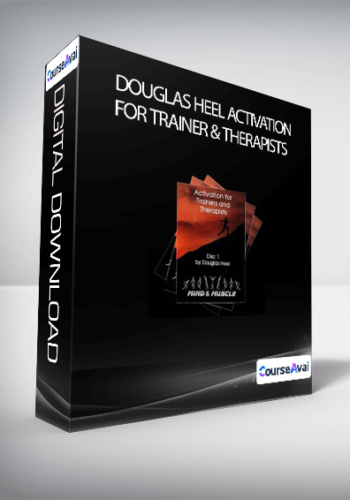Animal-Assisted Interventions: An Incredible Range of Therapeutic Benefits – Brooke Wimer
Original price was: $199.00.$50.40Current price is: $50.40.
Join animal-assisted therapy expert Brooke Wimer, MOT, OTR/L, and learn how incorporating animals into your professional activities can greatly improve client outcomes in a surprisingly broad range of areas.
Description
Unlock your potential with the Unlock your potential with the Animal-Assisted Interventions: An Incredible Range of Therapeutic Benefits – Brooke WimerAnimal-Assisted Interventions: An Incredible Range of Therapeutic Benefits – Brooke Wimer course for only course for only Original price was: $199.00.Original price was: $199.00.$$50.4050.40Current price is: $50.40.Current price is: $50.40. at at Giolib.comGiolib.com! Explore our comprehensive library of over 60,000 downloadable digital courses across various ! Explore our comprehensive library of over 60,000 downloadable digital courses across various Medical & HealthMedical & Health. Get expert-led, self-paced learning at up to 80% savings. Elevate your skills today!. Get expert-led, self-paced learning at up to 80% savings. Elevate your skills today!
DOWNLOAD IMMEDIATELY!
THE COURSE CONTENT BELOW:
 Animal-Assisted Interventions: An Incredible Range of Therapeutic Benefits – Brooke Wimer
Animal-Assisted Interventions: An Incredible Range of Therapeutic Benefits – Brooke Wimer
A toolbox of interventions for clients diagnosed with:A toolbox of interventions for clients diagnosed with:
- Trauma, anxiety, depression and PTSDTrauma, anxiety, depression and PTSD
- Mania and psychotic disordersMania and psychotic disorders
- Conduct and antisocial personality disordersConduct and antisocial personality disorders
- Cognitive disorders, dementia and strokeCognitive disorders, dementia and stroke
- Behavioral and personality disordersBehavioral and personality disorders
- Intellectual and learning disabilitiesIntellectual and learning disabilities
- Physical and occupational disabilitiesPhysical and occupational disabilities
Join animal-assisted therapy expert Brooke Wimer, MOT, OTR/L, and learn how incorporating animals into your professional activities can greatly improve client outcomes in a surprisingly broad range of areas, including:Join animal-assisted therapy expert Brooke Wimer, MOT, OTR/L, and learn how incorporating animals into your professional activities can greatly improve client outcomes in a surprisingly broad range of areas, including:
- Reduce stress and anxiety levels and lower blood pressureReduce stress and anxiety levels and lower blood pressure
- Lessen feelings of loneliness and poor self-esteem in those with trauma and anxietyLessen feelings of loneliness and poor self-esteem in those with trauma and anxiety
- Treat symptoms in people dealing with depression and PTSDTreat symptoms in people dealing with depression and PTSD
- Develop empathy in those with conduct disorder and antisocial personality disorderDevelop empathy in those with conduct disorder and antisocial personality disorder
- Improve physical function in people recovering from a strokeImprove physical function in people recovering from a stroke
- Improve reading and comprehension in children with learning disabilitiesImprove reading and comprehension in children with learning disabilities
- And more!And more!
You will receive specific examples of animal-assisted therapeutic goals in a variety of functional areas. You will develop a toolbox of animal-assisted interventions and animal-focused treatments you can employ the very next day. This seminar also includes the latest research outcomes and a solid foundational knowledge about the human-animal emotional bond. You will also discover very practical information and resources to help you develop programming and implement your own animal-assisted interventions.You will receive specific examples of animal-assisted therapeutic goals in a variety of functional areas. You will develop a toolbox of animal-assisted interventions and animal-phd/">focused treatments you can employ the very next day. This seminar also includes the latest research outcomes and a solid foundational knowledge about the human-animal emotional bond. You will also discover very practical information and resources to help you develop programming and implement your own animal-assisted interventions.
OUTLINEOUTLINE
Brief OverviewBrief Overview
- Human-animal emotional bondHuman-animal emotional bond
- Therapy animal vs. service animalTherapy animal vs. service animal
- Animal-assisted therapy, activities and educationAnimal-assisted therapy, activities and education
- Handler vs. clinician, clinician-animal teamsHandler vs. clinician, clinician-animal teams
- Animal-based interventions without an animalAnimal-based interventions without an animal
Mindfulness of Animals and How it Helps the Human BrainMindfulness of Animals and How it Helps the Human Brain
- The neuroscience of the human-animal bondThe neuroscience of the human-animal bond
- Why zebras don’t get ulcersWhy zebras don’t get ulcers
- Benefits of owning a companion animalBenefits of owning a companion animal
Interventions and Treatment Goals/OutcomesInterventions and Treatment Goals/Outcomes
- Mental, cognitive, emotional, and behavioral issues
Mental, cognitive, emotional, and behavioral issues
- Increase attendance and engagement in sessionsIncrease attendance and engagement in sessions
- Treat symptoms related to trauma, anxiety and depressionTreat symptoms related to trauma, anxiety and depression
- Decrease loneliness and improve self-esteemDecrease loneliness and improve self-esteem
- Develop empathy and encourage outward focusDevelop empathy and encourage outward focus
- Provide hope, meaning and purposeProvide hope, meaning and purpose
- Challenges with learning
Challenges with learning
- Improve reading and comprehensionImprove reading and comprehension
- Support vocabulary developmentSupport vocabulary development
- Increase verbal interactionsIncrease verbal interactions
- Physical and occupational issues
Physical and occupational issues
- Progress fine and gross motor skillsProgress fine and gross motor skills
- Improve sitting/standing balanceImprove sitting/standing balance
- Increase endurance and activity toleranceIncrease endurance and activity tolerance
- Facilitate improved sensory processingFacilitate improved sensory processing
Components of Animal-Assisted InterventionComponents of Animal-Assisted Intervention
- Selecting appropriate recipients for careSelecting appropriate recipients for care
- How to approach clientsHow to approach clients
- Interaction techniques for client and animalInteraction techniques for client and animal
- Closure, documentationClosure, documentation
Start Your Own Animal-Assisted ProgramStart Your Own Animal-Assisted Program
- Animal qualifications and characteristicsAnimal qualifications and characteristics
- Qualifications for cliniciansQualifications for clinicians
- Preparing and caring for the animalPreparing and caring for the animal
- When the animal shows signs of stress and agitationWhen the animal shows signs of stress and agitation
- Protecting your practice through risk managementProtecting your practice through risk management
- Organizations and resources for starting your animal-assisted programOrganizations and resources for starting your animal-assisted program
OBJECTIVESOBJECTIVES
- Identify evidence-based research outcomes regarding animal-assisted interventions.Identify evidence-based research outcomes regarding animal-assisted interventions.
- Implement animal-assisted interventions for people with mental health disorders including anxiety, depression, bipolar, schizophrenia and personality disorders.Implement animal-assisted interventions for people with mental health disorders including anxiety, depression, bipolar, schizophrenia and personality disorders.
- Design animal-assisted interventions to increase language and literacy in children with learning disorders.Design animal-assisted interventions to increase language and literacy in children with learning disorders.
- Design animal assisted interventions to address physical and occupational challenges.Design animal assisted interventions to address physical and occupational challenges.
- Employ animal-assisted interventions as a modality to treat people with dementia and other cognitive disorders.Employ animal-assisted interventions as a modality to treat people with dementia and other cognitive disorders.
- Apply knowledge to design your own animal assisted programming.Apply knowledge to design your own animal assisted programming.
- Explain the difference between a therapy animal, a service animal and an emotional support animal.Explain the difference between a therapy animal, a service animal and an emotional support animal.
Future-proof your knowledge with the Future-proof your knowledge with the Animal-Assisted Interventions: An Incredible Range of Therapeutic Benefits – Brooke WimerAnimal-Assisted Interventions: An Incredible Range of Therapeutic Benefits – Brooke Wimer course at course at GiOlibGiOlib! Enjoy lifetime access to high-quality digital content, crafted to advance your career and personal development.! Enjoy lifetime access to high-quality digital content, crafted to advance your career and personal development.
- Lifetime Access:Lifetime Access: Permanent access to all purchased courses. Permanent access to all purchased courses.
- Smart Savings:Smart Savings: Benefit from prices up to 80% off original course costs. Benefit from prices up to 80% off original course costs.
- Safe Transactions:Safe Transactions: Process your payments securely. Process your payments securely.
- Practical Insights:Practical Insights: Gain actionable skills relevant to today's demands. Gain actionable skills relevant to today's demands.
- Instant Availability:Instant Availability: Begin your course immediately after payment. Begin your course immediately after payment.
- Flexible Learning:Flexible Learning: Access content effortlessly on any device. Access content effortlessly on any device.
Start expanding your horizons with Start expanding your horizons with GiOlibGiOlib!!





